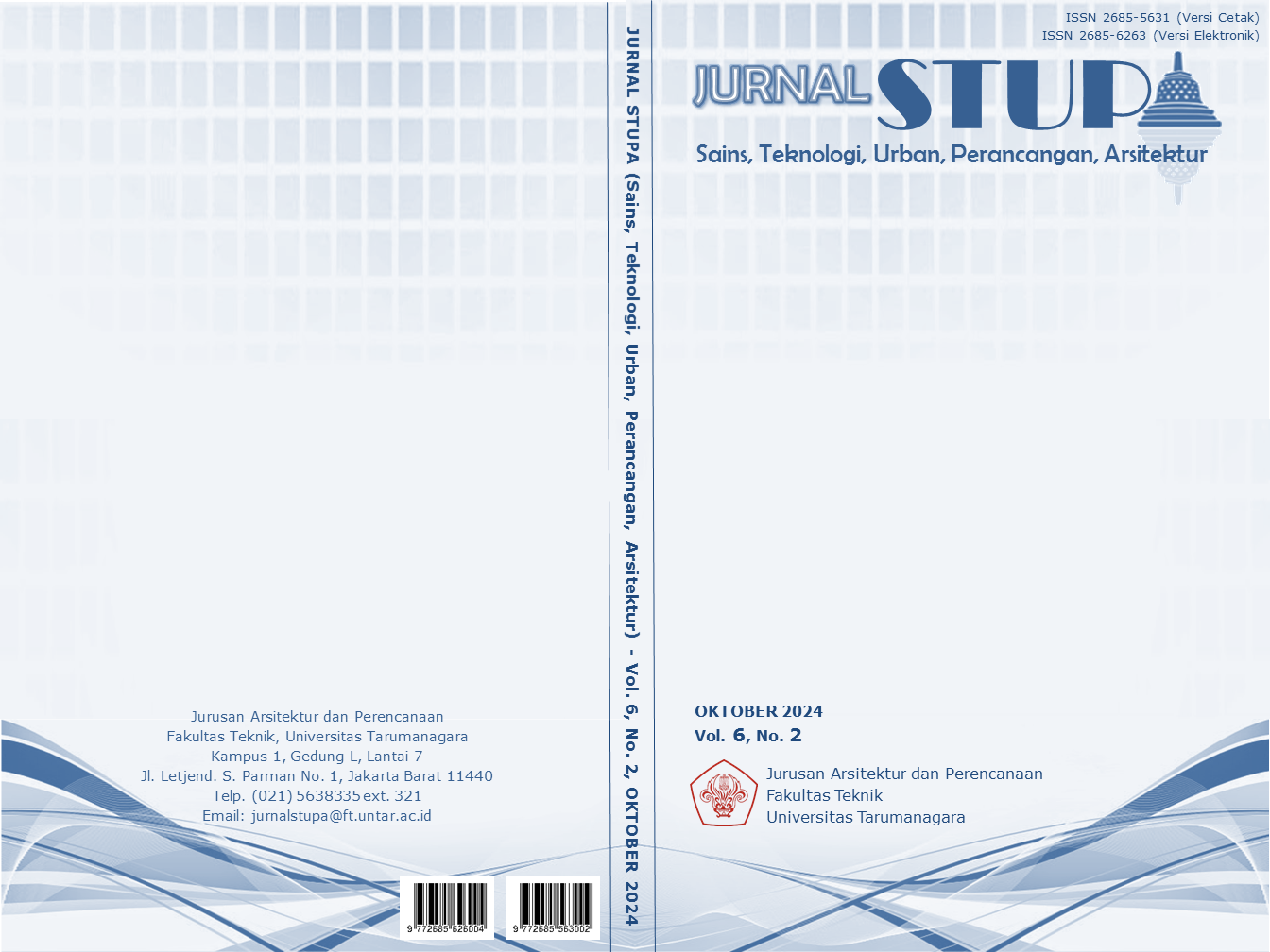INTEGRASI RUANG DAN KEHIDUPAN MELALUI ADAPTIVE REUSE DI KAWASAN SENEN, JAKARTA PUSAT
Main Article Content
Abstract
The Grand Theater Senen was one of the first single cinema buildings in Jakarta to be very popular in the 1980s. The Senen Grand Theatre's downturn was caused by the defeat of the competition due to the emergence of modern cinemas, as well as the degradation of the Senen area as a result of the monetary crisis. Although the government has attempted to revitalize the Senen Area several times, there are only a few crowded points. As a result of the degradation, the GTS was abused as a venue for blue films, drug sales, and prostitution. Currently, the building is abandoned. The location of the building is in Simpang Lima or Senen Triangle Area, one of the high-mobility intersections in central Jakarta. In this context, the research aims to understand the role of environmental damage and area degradation in building conditions, by proposing Adaptive Reuse as a primary solution. The plan includes the development of people-crossing bridges (JPOs), capsule hotels for commuters, rental offices, and commercial areas, which not only enhance connectivity but also create a more comfortable, secure, and sustainable environment, so that GTS can support the economic growth of communities especially in the dynamic Senen Area, while improving the quality of life of people and improving neglected environmental conditions, making GTS a functional hub that can facilitate both outdoor and indoor accessibility, providing safe and comfortable accommodation.
Keywords: Adaptive reuse; Commuter; Hotel capsule; Interconnection; Rent virtual office
Abstrak
Grand Theater Senen merupakan salah satu gedung bioskop tunggal pertama di Jakarta yang sangat populer pada era 80-an. Kemunduran Grand Theater Senen disebabkan oleh kalah saing karena kemunculan bioskop modern, juga terjadinya degredasi pada Kawasan Senen yang disebabkan oleh krisis moneter. Walaupun pemerintah sudah berupaya melakukan revitalisasi Kawasan Senen beberapa kali, namun hanya ada beberapa titik yang ramai. Akibat dari degredasi tersebut, GTS disalahgunakan sebagai tempat pemutaran film biru, penjualan narkoba, dan prostitusi. Saat ini, bangunan tersebut terbengkalai. Lokasi bangunan ada di Simpang Lima atau Kawasan Segitiga Senen, salah satu persimpangan yang memiliki mobilitas tinggi di Jakarta Pusat. Dalam konteks ini, penelitian bertujuan untuk memahami peran kerusakan lingkungan dan degradasi kawasan dalam kondisi bangunan, dengan mengusulkan Adaptive Reuse sebagai solusi utama. Rencana ini mencakup pengembangan jembatan penyeberangan orang (JPO), hotel kapsul untuk komuter, kantor sewa, dan area komersial, yang tidak hanya meningkatkan konektivitas namun juga menciptakan lingkungan yang lebih nyaman, aman, dan berkelanjutan, sehingga GTS dapat mendukung pertumbuhan ekonomi masyarakat terutama di Kawasan Senen yang dinamis, sambil meningkatkan kualitas hidup masyarakat dan memperbaiki kondisi lingkungan yang terabaikan, menjadikan GTS sebagai sebuah hub fungsional yang dapat memudahkan aksesibilitas baik dari luar maupun dalam ruangan, penyediaan akomodasi yang aman dan nyaman.
Article Details

This work is licensed under a Creative Commons Attribution-NonCommercial-ShareAlike 4.0 International License.
This work is licensed under a Jurnal Sains, Teknologi, Urban, Perancangan, Arsitektur/ STUPA Creative Commons Attribution-NonCommercial-ShareAlike 4.0 International LicenseReferences
Christopher, A., Ishikawa, S., & Silverstein, S. (1977). A Pattern Language: Towns, Buildings, Construction. USA: OUP.
J, M., & Ross, P. (2003). The 21st Century Office. Laurence King Publishing.
Kurokawa, K. (1987). Van Nostrand Reinold. Capsule Architecture.
Lynch, K. (1960). The Image of the City. MIT Press.
Marlina, & Endy. (2008). Panduan Perancangan Bangunan Komersial. Penerbit Andi.
Misirlisoy, D., & Gunce, K. (2016). Sustainable Cities and Society 26. Adaptive reuse strategies for heritage buildings: A holistic approach.
Plevoets, B., & Cleempoel, K. V. (2012). RIE INTERNATIONAL CONFERENCE 2012. ADAPTIVE REUSE AS A STRATEGY TOWARDS CONSERVATION OF CULTURAL HERITAGE: A SURVEY OF 19TH AND 20TH CENTURY THEORIES.
Relph, E. (1976). Place and Placelessness. United Kingdom: Pion.
Seamon, D., & Sowers, J. (2008). Place and Placelessness, Edward Relph. Place and Placelessness, Edward Relph.
Seamon, D., & Sowers, J. (2008). Place and Placelessness, Edward Relph. Place and Placelessness, Edward Relph. Place and Placelessness, Edward Relph. Place and Placelessness, Edward Relph.



